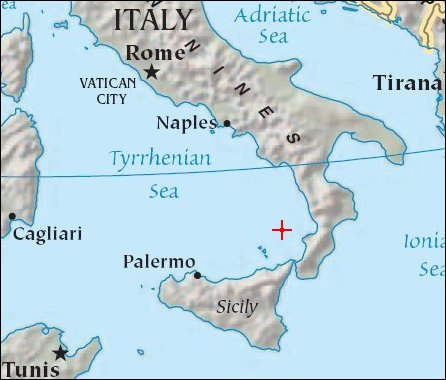| Earth from Space is a free eBook describing our planet from a satellite's perspective. Fore more information, please read the About pages. |

|

Home  Europe Europe  Italy Italy  Stromboli Volcano Stromboli Volcano |
|
| See also: Ash Plume from Mount Etna | |






|
|
Stromboli VolcanoPosition of center of photo (Lat/Long): [38.789/15.213] |
|
  On February 27, 2007, the Stromboli Volcano (Italy) underwent a strong eruption. According to the BBC, two new craters opened on the volcano’s summit, producing twin lava flows. One of those lava streams reached the sea the same day, sending up plumes of steam as the scalding lava touched the cool water. Although authorities did not anticipate an evacuation of the volcanic island, they restricted access to high-risk areas. According to Volcano Discovery, seismic activity continued several days later, including rockfalls. On February 27, 2007, the Stromboli Volcano (Italy) underwent a strong eruption. According to the BBC, two new craters opened on the volcano’s summit, producing twin lava flows. One of those lava streams reached the sea the same day, sending up plumes of steam as the scalding lava touched the cool water. Although authorities did not anticipate an evacuation of the volcanic island, they restricted access to high-risk areas. According to Volcano Discovery, seismic activity continued several days later, including rockfalls.
On March 8, 2007, the Advanced Spaceborne Thermal Emission and Reflection Radiometer (ASTER) on NASA’s Terra satellite captured this image. It is an infrared-enhanced, "false-color" image in which bare ground is gray, water is dark blue, and vegetation is red. Clouds, possibly mixed with steam, cover the new lava flow. The dark flow down the northwest side of the volcano separates the two areas of human settlement seen in this image. The towns of Piscita, Ficogrande, San Vincenzo, and Scari form the bright silver dots on the northeastern shore, while Ginostra is the small town on the western shore. Stromboli is a stratovolcano composed of alternating layers of hardened ash, lava, and volcanic rocks. Strong eruptions have been recorded at the volcano for more than 1,000 years. In 2002, a major eruption caused a small tsunami and damaged Stromboli Village on the north side of the island. Eruptions at Stromboli are not unusual. In fact, mild explosions and glowing lava flows are so frequent that the volcano has earned the name "Lighthouse of the Mediterranean," says the Smithsonian’s Global Volcanism Program. The island of Stromboli is the tip of the massive underwater volcano. The island grows as the volcano continues to pump out fresh lava. As of March 6, the ongoing eruption had added a new 200-meter-wide delta that stretches 50-100 meters into the ocean, said Volcano Discovery. |
| Source of material: NASA |
Further information: WikiPedia article on Stromboli Volcano
Last Update: 2011-03-30

